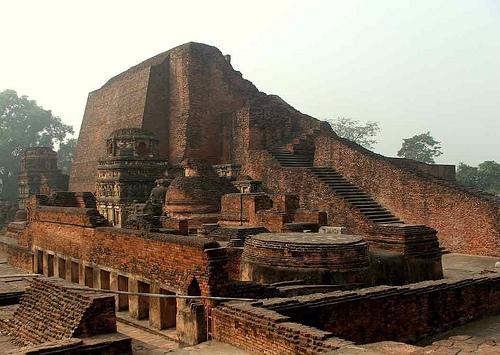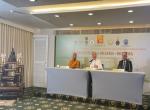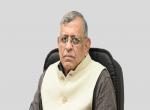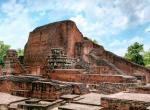The great Nalanda University of yore is being sought to be revived and the ongoing effort since 2007 has been widely projected and discussed. It is but natural that the state of Bihar has been selected as the venue for recreating what was once undoubtedly, one of the leading knowledge-lighthouses of the world. While the thought needs national acclaim and the effort national support, certain uncomfortable questions remain hinting at a certain degree of confusion or lack of foresight in evolving the support system that shall eventually see the project through. A brief survey first, of some of these questions will perhaps give an idea of the deeper malaise that seems to be subtly plaguing the effort at its inception.
Why, for example, does the Mentors Group of the proposed university comprising of public intellectuals, scientists, academics and bureaucrats not have a single representation from the Tibetan community.1 A glaring omission considering the historic-religious link that Tibetan Buddhism and Nalanda had and the fact that successive Tibetan monarchs in history, had through their munificence, hosted and established in Tibet a number of masters from the Nalanda Mahavihara. It was, in fact, through the efforts of these teachers from Nalanda that the ‘Golden Age of Tibet’ was inaugurated.2 In his seminal study of ‘Indian Teachers of Buddhist Universities’ noted scholar Phanindranath Bose lists at least 14 major and minor ‘Pandits of Nalanda’ who either went on to establish solid academic credentials in Tibet or wielded a wide influence in that region through their works. Nalanda sent missionaries ‘to China and to Tibet, notes Bose, and ‘was also a great centre of Tibetan learning’ where Indian pandits ‘learned Tibetan [and] translated numerous Buddhists books from the Sanskrit.’ It was through these translations that ‘they [pandits] instilled the principles of Buddhism in Tibet.3 Numerous historical evidences exist in support of this link. For example in the eighth century, king ‘Khri-sroṅ-deu-tsan’ of Tibet ‘invited several Indian pandits to his court to propagate Buddhism in his kingdom’, among the invitees was the great ‘Ācārya Sānta Raksita.’ It was on the Acārya’s advice that the king constructed ‘the first Buddhist monastery of Tibet - ‘Sam-ye’. Sānta Raksita worked for 13 years in Tibet and died there in C.E.762. In recognition of his work for the ‘cause of Buddhism’ he was conferred the honorific of ‘Ācārya Bodhisattva’4 by the Tibetans.
Even in our times the Tibetans have done much to keep alive the flame of Buddhist teaching and knowledge as symbolized by Nalanda and have propagated it globally. In India their efforts have been symbolized by such institutions as the Central Institute of Higher Tibetan Studies at Sarnath, near Varanasi and the Central Institute of Buddhist Studies in Leh. It would be interesting to recall that just five days before his death on 27th May, 1964, Jawaharlal Nehru was closeted with the Dalai Lama in New Delhi and a discussion on the necessity of establishing a ‘central organisation to preserve Tibetan knowledge and culture’ ensued.5 The exclusion thus of the Dalai Lama or his representatives, or of any other representatives of Tibetan Buddhism from the Mentors Group requires more than a passing explanation from those entrusted with the work of drawing up the first plans of the University. The Chief Mentor, Professor Amartya Sen’s answer, when asked whether the Dalai Lama was associated with the project that, ‘He is heading a religion [and being] religiously active may not be the same as (being) appropriate for religious studies’6 speaks volumes of the group’s ‘understanding’ of the essence of religious studies and practice within the Indic paradigm. Being religiously active was an essential pre-requisite for the study of religion in the Eastern context. The religion and philosophy of India was the ‘Science of the Self’ (Adhyātma-vidyā)7 and it was only through an assiduous study of this vidyā (Science) that one could begin to practice it. In the ancient Indian scheme of things, at least when the older Nalanda was in its full bloom, the dichotomy between being religiously active and studying religion did never really exist.
While China’s link and relevance to the project is being reiterated primarily through the Xuanzang (Hsüan-tsang) factor and the historical records which talk of several teachers also going to China from Nalanda – such as Dharmadeva who visited China in the latter half of the 10th century and was appointed ‘a member of the Imperial Board for the translation of Indian Buddhist text’ during the Song Dynasty (C.E. 960-1127),8 - the Tibetan Buddhist connection to Nalanda cannot be discounted or overlooked. Why the Tibetans, one does not hear, as yet, of any effort to include the Koreans who, as records indicate, had also visited Nalanda during a period of thirty years following Xuanzang’s departure from that seat of learning.9 The inclusion and involvement of the Tibetans and a host of others, who fell within the ambit of the influence of Nalanda, as radiated through its spread of Buddhism, would be a true symbolic representation of the civilisational and cultural confluence that the ancient seat actually embodied. A selective approach will only serve to reinforce the perception that the whole project is imbued with an exclusionary outlook arising out of the need to satisfy a large and powerful regional player bent on controlling and infiltrating academic and knowledge instruments in its neighbourhood. Ironically it was through Nalanda that India controlled, in a sense, the mind and thought of China and the whole surrounding region for nearly two thousand years!
Another question that needs adequate answering in order to clear the air on the intent and aim of the whole exercise may be mentioned in passing. Why has the Ministry of External Affairs (MEA) and not the Ministry of Human Resource Development (MHRD) been designated as the nodal agency for the University, is not clear. While the reason given that an international university must be spearheaded by the MEA and that there should be no centralisation of the function of education10, is debatable – this was at least an opportunity for the MHRD to initiate an international project and to strike greater global partnerships and as well as develop a universal vision of education and educational systems.
Be that as it may, what perhaps needs greater thought is the question of the deeper raison d’être of a Nalanda University in our times. Will it be just another University eventually specializing in the areas of information technology, management and engineering – namely the physical sciences – simply to cater to the inordinate market demand for these subjects? Will the proposed international university, with a supposedly universal message, end up functioning as a local body with a provincial vision? Will it be bogged down by elaborate officialese and follow the beaten track in pedagogical and instructional methods or will it chart out an altogether new path in these and recreate the ancient spirit of learning that Nalanda signified. In his once acclaimed, but now forgotten work, ‘Men and Thought in Ancient India’ noted historian R.K.Mookerji briefly describes the spirit and outlook of teaching and learning that once pervaded Nalanda. Nalanda was, writes Mookerji, ‘a true University in the universality of its studies, in its ideal of freedom in learning, welcoming knowledge from all quarters, from all sects and systems, and, lastly, in its pedagogic method, the method of discussion for higher learning.’11 Nalanda signified ‘liberty and liberality’ in learning then prevalent all over India, the learners were encouraged and trained to diligently follow their ‘own tenets, pondering, urging objections, raising doubts, resolving them, giving etymologies, disputing, studying, and explaining.’12 It is this principle of ‘liberty and liberality’ in education – now lost because of a long strain of an education that has broken the ‘threads of tradition’ and severed the ‘continuity of Indian life’13 – that could perhaps be the inspirational core of the new effort. Any attempt at merely replicating aspects of the present university system would perhaps only serve to stultify the original vision.
It has been vociferously argued, for example, that the proposed university should not exclusively teach ‘Humanities, Arts and Literature or Historical Studies’14and must equally encourage other subjects. While there is no apparent fault with that line of thought, one could equally ask as to why not have an exclusive centre of international learning dedicated to the furtherance of the studies of humanities and why not have it in India? There is a plethora of internationally acclaimed technical institutions already in India and the government continues to diligently churn out a whole lot of these annually, while the sore truth is that the state of humanities in most of our institutions of higher learning leaves much to be desired. Educational institutions today that ‘are not institutes of technology or medicine or management’ have lost much of their glitter or preeminence.15 In contrast Nalanda, though it also taught technical subjects such as medicine (chikitsā-vidyā), mathematics and astronomy, did evolve into a ‘genuine centre of intellectual debate’ by emphasising subjects such as linguistics, state-craft and logic, apart from topics of religion-philosophy-metaphysics that were central to its system.16 Why not therefore, seek to recreate the grandeur of Nalanda in the field of humanities and make special efforts in it to develop pioneering courses in humanities?
Another interesting feature of ancient Nalanda, worth considering and perhaps emulating in the present effort, was the idea of social responsibility of educational institutions. The ancient University, it appears, was not just an institution of higher learning isolated from its surrounding and happy in the thought that its only service to society was the imparting of knowledge and preparing scholars. Apart from being a premier seat of learning it was also ‘an emporium which supplied medicines to the sick, alms to the beggar, garments to the naked, and shelter to the homeless.’17 It combined a number of features – a monastery for monks to reside, a University and a library, a ‘hospital, and finally a free institution, catering to all the needs of the poor.’18 This spirit of social responsibility could perhaps be revived today in institutions of higher learning by urging them to undertake specific developmental projects. The new project of Nalanda may well be the first to suggest such a practice nationally, for all institutions of higher learning.
At a deeper level, it could be said, that Nalanda enhanced the ‘phenomenon of [a] peaceful acculturation unparalleled in the history of religion’ which saw Buddhism spread to central Asia through Afghanistan and through the ‘Fabled Silk Road’ from India into China.19 It was truly an international university and ‘races belonging to different climates, habits and languages were drawn together [there], not in the clash of arms, not in the conflict of exploitation, but in harmony of life, in amity and peace.’20 The real raison d’être then of the whole Nalanda University project could perhaps be the regeneration of this convergence and unity that the ancient seat symbolized. The heart and essence of the Indian experience speaks always of unity and is inspired by the constant ‘intuition of the unity of all life, and the instinctive and ineradicable conviction that the recognition of this unity is the highest good and uttermost freedom.’21 The true universality of the Nalanda project will only emerge when it projects and manifests this unity through a global confluence of thought, culture and knowledge and aspires to become, like the old, ‘the most global university of its time.’ The sustaining aims of this exercise at recreation might well be the ones suggested, interestingly, by Jeffrey Garten, former dean of the Yale School of Management – [it can aspire to be] ‘a great global university that reaches deep into the region’s underlying cultural heritage, restores many of the peaceful links among peoples and cultures that once existed…[it] should try to recapture the global connectedness of the old one’ and could set a ‘bench mark for mixing nationalities and cultures’, inject ‘energy and direction into global subjects’ and develop ‘true international leaders’ and strive for ‘religious reconciliation on a global scale’.22 All of them surprisingly are areas in which Indian civilisation and thought once excelled. Moreover, an overarching vision shall easily discern in such a project the potential for developing a formidable instrument for wielding the influence of soft power in the region and beyond.
To Xuanzang (Hsüan-tsang) and his compatriots, India and her culture were termed as Yin-tu. It meant the ‘moon’ to them and was applied to India because like the moon, India [was perceived] to be the ‘only country which, through a regular succession of great sages, illumined the spiritual darkness in which humanity was merged at the setting of the sun of the Buddha.’23
The deeper raison d’être then, of the proposed new Nalanda in our time, may well be – however esoteric it may sound to some – the rekindling of this very illumination!
Endnotes/ References
1 : Priyadarsi Dutta, ‘Nalanda Farce Unfolds’, The Pioneer, September 14, 2010, New Delhi.
2 : Will Durant, Story of Civilisation – Part-I – Our Oriental Heritage, (New York: Simon & Schuster, 1954) p.506.
3 : Phanindranath Bose, Indian Teachers of Buddhist Universities, (Madras: Theosophical Publishing House, 1923), p.106.
4 : Ibid., pp.124-125.
5 : Dutta, op.cit.,
6 : Andrew Buncomb, ‘University Reborn After 800 Years’, The Statesman, 5 August, 2010, Kolkata.
7 : Ananda Coomaraswamy, The Dance of Shiva (1918), (New Delhi: Munshiram Manoharlal, 9th imp, 2009), p.27.
8 : H.D.Sankalia, The University of Nalanda – Studies in Indian History of The Indian Historical Research Institute – Vol. XII, (Madras: B.G.Paul & Co., 1934), p.. 202.
9 : A. Ghosh, A Guide to Nalanda, (Delhi: Archeological Survey of India, 1939), p.43.
10 : Dr. Karan Singh, Rajya Sabha Debate on the Nalanda University Bill, August, 2010, New Delhi.
11 : Radha Kumud Mookerji, Men and Thought in Ancient India (1924), (Delhi: Motilal Banarsidass, reprint, 1996), p.171.
12 : Ibid., p.172.
13 : Coomaraswamy, op.cit., p.170.
14 : H.K.Dua, Rajya Sabha Debate on the Nalanda University Bill, August, 2010, New Delhi.
15 : Pavan.K.Varma, Becoming Indian- the Unfinished Revolution of Culture and Identity, (New Delhi: Allen Lane, 2010), pp. 156-158.
16 : Varma, op.cit., p.158, Mookerji, op.cit., p.170.
17 : Sankalia, op.cit., p.205.
18 : Ibid., pp.205-206.
19 : Michel Danino, Indian Culture and India’s Future, (New Delhi: D.K.Printworld, 2011), p.52. For a detailed analysis of this process of acculturation vide chapter on ‘India’s Gifts to the World.’
20 : Sankalia, op.cit., p.206.
21 : Coomaraswamy, op.cit., pp.21-22.
22 : Jeffrey.E.Garten, ‘Really Old School’, New York Times, December 9, 2006.
23 : Radha Kumud Mookerji, Ancient Indian Education – Brahmanical and Buddhist (1947), (Delhi: Motilal Banarsidass, 4th ed., 1969), p.503.
---------------------------------------
Published Date : 27 January 2011










Post new comment